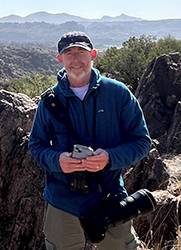-
Biogeography of plant invasions. I am particularly interested in the factors that influence invasion success over broad-geographic and temporal spatial scales. My research focuses on the invasive grass, Phragmites australis. We have explored the effects of latitude, natural enemies (i.e., herbivores, pathogens), higher trophic levels, soil microorganisms, plant genetics (ploidy, genome size, and genotypic variation), plant defensive chemistry, the metabolome and climate change on invasion success and interactions with other members of the recipient community. More details about this research can be found by clicking here. - Causes for predator-prey population cycles. Understanding the mechanisms promoting stability of predator-prey interactions has been a longstanding interest of mine. I have been studying a model system involving the cowpea weevil (Callosobruchus maculatus) and its parasitoid (Anisopteromalus calandrae) that is known to exhibit outbreak cycles in the laboratory. My colleagues and I have performed experiments to test the underlying causes of these outbreak cycles. Specifically, we are interested in whether changes in the age structure of the prey (specifically, the duration and variability of prey development time) affect predator-prey population cycles and stability (for more details, click here).
- Density-dependent dispersal and predator-prey population dynamics. Dispersal can have major consequences for individual fitness, population dynamics, and species’ distributions. Understanding the causes and consequences of dispersal at both the patch and landscape levels is vital for population management and conservation. The paradigmatic view of dispersal is that it becomes more frequent as density increases. However, the pattern of density-dependent dispersal can take many forms. My colleagues and I are using mathematical models and experiments to assess how the density of competitors and natural enemies can affect the form forms of dispersal, and ultimately coexistence among interacting species. For more details about this research, click here.
- Role of habitat fragmentation and landscape heterogeneity on predator-prey spatial and temporal population dynamics. A long-standing research interest of mine has focused on the planthopper Prokelisia crocea and its egg parasitoid Anagrus columbi that coexist among discrete patches of prairie cordgrass in the tallgrass prairies of North Dakota. My students and I have experimentally examined how cordgrass patch and landscape structure influenced host and parasitoid foraging and dispersal behavior, extinction risk, and population dynamics. My colleagues and I have also developed behavior-based landscape-level models to understand the effects of habitat heterogeneity on the population dynamics of interacting species. Offshoots of this work involved the effects of invasive exotic plants on the population dynamics of native fauna, and the use of stepping stones and corridors in promoting connectivity among habitat fragments. More details on this research project can be found by clicking here.
James T. Cronin
George C. Kent Professorship in Life Sciences #3
SEE Division
PhD: Florida State University, 1991
Phone: 225-578-7218
Lab Phone: 225-578-7221
Office: A306 Life Sciences Annex
Lab: A359/A361 Life Sciences Annex
E-mail: jcronin@lsu.edu
Area of Interest
My research interests center on the ecology and evolution of plant-herbivore-natural enemy interactions. This stems from both an applied interest in the biological control of plant pests by natural enemies and a theoretical interest in the behavior, population dynamics and persistence of species comprising ecological communities. In my research program, I advocate a spatial approach to understanding these trophic interactions.
My current research interests focus on four broad areas
I welcome inquiries from prospective graduate students interested in research opportunities in my laboratory. Possible areas of study include all aspects of plant-insect interactions, insect predator-prey interactions, plant-soil feedbacks, spatial and landscape ecology, invasion biology, and conservation biology.
Selected Publications
Meyerson, L. A., J. T. Cronin, J. Packer, P. Pyšek, K. Saltonstall. 2025. Ecology and evolution of Phragmites australis, one of the world’s most successful plant species. Annual Review of Ecology, Evolution and Systematics. In press.
Glassmire, A., A. Salgado, J. Johnston, R. Diaz and J. T. Cronin. 2024. The effects of environmental stressors on above- and below-ground phytochemical diversity of a threatened wetland grass. Plants https://doi.org/10.3390/plants13223133.
Elsey-Quirk, T., A. Lynn, M. D. Jacobs, R. Diaz, J. T. Cronin, L. Wang, H. Huang, and D. Justic. 2024. Vegetation die-off in the Mississippi River Delta triggered by acute drought and chronic relative sea-level rise. Nature Communications DOI: 10.1038/s41467-024-47828-x.
Cronin, J. T., J. Goddard II, A. Muthunayake J. Quiroa and R. Shivaji. 2024. Predator-induced prey dispersal can cause hump-shaped density-area relationships in prey populations. Journal of Mathematical Biology. DOI: 10.1007/s00285-023-02040-1
Cronin, J. T., J. Goddard II, A. Krivchenia and R. Shivaji. 2023. Density dependent within-patch movement behavior of two competing species. Evolution and Ecology. https://DOI.org/10.1002/ece3.10753.
Lee, H., R. Diaz, J. Johnston, I. A. Knight, J. A. Nyman and J. T. Cronin. 2023. Vegetation restoration following dieback of Phragmites australis in the Mississippi River Delta, USA. Wetlands: https://doi.org/10.1007/s13157-023-01746-8.
Salgado, A. L., A. E. Glassmire, B. E. Sedio, R. Diaz, M. J. Stout, J. Cuda, P. Pyšek, L. A. Meyerson and J. T. Cronin. 2023. Metabolomic evenness underlies intraspecific differences among lineages of a wetland grass. Journal of Chemical Ecology. 49: 437-450
Goddard II, J., R. Shivaji and J. T. Cronin. 2022. Ecological release and patch geometry can cause nonlinear density-area relationships. Journal of Theoretical Biology: https://doi.org/10.1016/j.jtbi.2022.111325.
Harms, N. E., J. T. Cronin and J. Gaskin. 2021. Increased ploidy of Butomus umbellatus L. in introduced populations is not associated with higher phenotypic plasticity to N and P. AoB Plants 13: https//doi.org/10.1093/aobpla/plab1045.
Cronin, J. T., J. Johnston and R. Diaz. 2020. Multiple potential stressors and dieback of Phragmites australis in the Mississippi River Delta, U.S.A. Wetlands 40: 2247-2261.
Cronin, J. T., J. D. Reeve, D. Xu, M. Xiao and H. N. Stevens. 2016. Variable prey development time suppresses predator-prey cycles and enhances stability. Ecology Letters 19: 318-327.